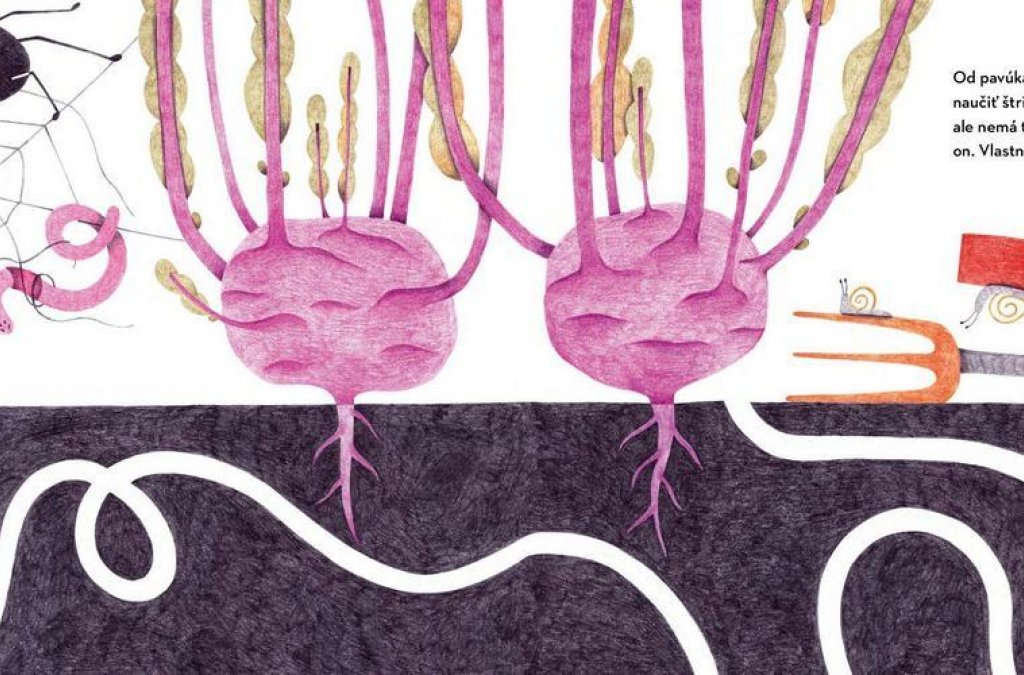
2020 has been an exceptionally good year for earthworms – they appeared in two books! Dážďovky and František z kompostu [Earthworms and Frantisek from the Compost]. Both books offer facts, each in a unique way and with a different authorial objective.
The authors Simona Čechová (František z kompostu) and Lucia Šukolová (Dážďovky) are ideologically aligned at the base of their books – earthworms and their function within the ecosystem. In the next approach to the primary idea, they chose distinctly separate ways. Illustration and design are dominating elements in both books. We are used to the high esthetic quality of both publishing houses (Monokel: Cesta do krajiny draka, Toddler Punk, Takto vidím and others; E.J. Publishing: Jana, líška a ja, the comic books Čierna oslava, Bežná, Pé Er Dé and Unesení).

Illustrations – serving the story and education
Čechová’s František z kompostu is an authorial and illustrational combo. Illustration does not complement the plot and it does not uncover what is hidden. Instead, it underlines the story and visually zooms in. It provokes thinking about other creatures that live near František. Using them as a backdrop, we can build new stories, deepen the book’s theme, find relations and, most importantly, analyze them within the context of the book or in connection to our own existence. The style and color of the illustration is not mawkish and it corresponds with the age group 3+.
Montessori techniques are used In the book Dážďovky, adding value. Boris Meluš chose a black-and-white design with geometrical forms and letters. Babies are able to distinguish only a significant color contrast. The combination of black and white is welcome with babies under 6 months, but at further stages, it is recommended to add colors to stimulate sight development. However, the book may be attractive for other age groups as the black and white format looks clean and unclogged. Furthermore, it divides the important parts.

In Dážďovky, the illustration is an equal component of the text. It is also educative and relevant in its content. It broadens the age focus because it stimulates various age groups, from the smallest ones up until early school years. While the babies distinguish, older children can improve their fine motor skills. By using an earthworm, Šukolová and Meluš prepared a publication that teaches how to write, draw and examine. They also hint at symbolic overlaps.
“Sometimes the clouds break and rain starts. Water drops fall from the sky.” On the page with this text we find short lines that represent the rain, but that also look exactly like earthworms. They, too, have a “white dot” – a tiny head. And we all know that rain is connected with earthworms (in Slovak even by name: dážď – dážďovky). Thanks to the design, we can see the content’s overlap in the presence of letters. With imagination, all of them – capital, small, block and cursive – transform into wriggling earthworms. Or vice versa.

Lucia Šukolová’s text, just like the text of Simova Čechová, does not take up much space. Šukolová uses it as a means to further interaction with the illustration and as a device that supports the Montessori technique. Čechová’s book is less factual. It tells the story of the earthworm František with sparse, focused sentences.
Exceptionality within the ecosystem
We get to know him in the introduction and simultaneously, we are entering the plot: “František is a cheerful earthworm, but one thing bothers him. All of his friends are good at something, they excel in something and he is the only one who still doesn’t know what interests him. He feels useless.” The problem is stated clearly and explicitly. (Similarly so in the book Johanes Jensen has a feeling that he’s different, in which the principle of uncovering the topic is used right in the title.)

We read about František’s journey of self-discovery, of looking for ways to be useful and finding what he can offer to the world. Čechová uses a hyperbole when she presents František as the best (in making tunnels and soil loosening, in his case). Here, we lose some of the book’s message because when we think about it: does one – a person, an earthworm or whoever – have to be best or is good quite enough. Despite of this, František teaches us how to look back at what we have achieved and at what good/useful we hav done for the world. The book gains complexity thanks to the other characters. Even though the author does not let them speak, we realize that everyone, no matter what she does, has its purpose. Šukolová does not aspire for a loftier meaning. Instead, she builds on other – educative – qualities.
Excessively on compost
František z kompostu has another – let’s say bonus – part. A compilation of information on compost and how to treat it as well as additional information on earthworms. Its presence is understandable and yet it disrupts the concept of the book and feels redundant. From the reader’s perspective the book ended with František’s epiphany. Even though the author picked interesting facts and presented them in an age-appropriate manner, I would still advise to publish this part in a magazine and make a separate book out of it, one that aims to inform. I ask myself what the goal of the book was: teach about compost or point toward the fact that we are all good enough – in whatever it is we do.
However, it is suffice to say: congratulations to both authors, to the graphic designer and to their respective publishers. Period.
The review has originally appeared in the magazine Knižná revue 2/2021 in Slovak language